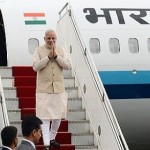Clean energy was high on Prime Minister Narendra Modi’s agenda during his just-concluded three-nation tour. Among the 26 agreements signed between Indian and Chinese firms, four were proposals for setting up solar photovoltaic cell manufacturing facilities in India[1].
India has set an ambitious target of putting up 100,000 megawatts of solar power by 2022—and solar cells have to be locally manufactured in order to achieve that goal.
Modi’s visit to Mongolia was the first ever by an Indian prime minister to the mineral-rich, land-locked country. Mongolia’s reserves of coal or copper however are not of interest for India, because they are low-value and high-bulk, and the logistics of bringing them to India are not feasible.
It is Mongolia’s uranium—although it is not being mined at present—that is of interest to India. The two countries have entered into an agreement on nuclear energy,[2] under which Mongolia could export uranium to India. India wants to triple its nuclear power capacity by 2025 (it started working towards this goal in 2014), for which it needs reliable fuel supply[3].
In South Korea, Prime Minister Modi visited Hyundai’s shipyard and invited Korean investment for building liquefied natural gas (LNG) tankers in India[4]. India will need these tankers if it wants to scale up its natural gas imports. Natural gas can be used as a transport fuel and also to generate power, plus it is environmentally cleaner compared to either petroleum or coal. Using more LNG instead of these two fuels is one way of keeping India’s carbon footprint smaller.
But it is not only during these recent trips that Modi has focused on clean energy. It has been a significant part of his agenda over the last year when he visited Bhutan, Nepal, Japan, the U.S., Australia, France, Germany, and Canada. During all these visits, non-fossil fuel-based energy—hydropower, nuclear energy, or renewable energy—was an important part of the bilateral discussions.
During his visits to Bhutan and Nepal, Modi inaugurated hydropower projects which are being set up with Indian help and will eventually sell electricity to India[5] [6]. With Canada, India has just concluded a five-year uranium supply agreement, and a similar deal is being explored with Australia, which is also rich in uranium[7][8]. The U.S., Japan, and France are all potential technology suppliers for nuclear reactors, while Germany will help India meet its target of 175,000 mw of renewable energy by 2022.[9] Germany is a leader in solar and wind energy, and gets 9% of its total energy needs from renewable energy.[10]
These agreements with immediate neighbours, raw material suppliers, and technology providers indicate the government’s clear will to reduce India’s dependence on coal, which generates over 75% of the country’s electricity [11].
India currently accounts for 5.5% of global carbon emissions, though it has over one-sixth of the world’s population. India’s per-capita carbon emissions are less than one-fourth the per-capita emissions of China, and less than one-tenth the per-capita emissions of the U.S. Clearly, if India follows the development model pioneered by the West or China, it will have adverse consequences for the global environment.
At the same time, as India grows, its energy needs are going to increase. By exploring and adopting options such as nuclear, hydro, and renewable energy, India is trying to take a more responsible approach to development. By successfully moving further along the path of clean energy, India can pioneer a different development model for other large under-developed countries such as Nigeria, Bangladesh, and Pakistan.
Amit Bhandari is Fellow, Energy & Environment Studies, Gateway House.
This blog was exclusively written for Gateway House: Indian Council on Global Relations. You can read more exclusive content here.
For interview requests with the author, or for permission to republish, please contact outreach@gatewayhouse.
© Copyright 2015 Gateway House: Indian Council on Global Relations. All rights reserved. Any unauthorized copying or reproduction is strictly prohibited.
[1] Swarup, Vikas. “List of B2B Agreements Signed during PM’s Visit Shows China Inc. Commitment to Make in India.” Twitter. May 15, 2015. Accessed May 20, 2015. https://twitter.com/MEAIndia/status/599456545626202113.
[2] “Nuclear Power Generation.” Lok Sabha. July 30, 2014. Accessed May 20, 2015. http://164.100.47.132/LssNew/psearch/QResult16.aspx?qref=3932.
[3] “Nuclear Reactors to Be Constructed.” Lok Sabha. April 22, 2015. Accessed May 20, 2015. http://164.100.47.132/LssNew/psearch/QResult16.aspx?qref=14956.
[4] Swarup, Vikas. Twitter. May 18, 2015. Accessed May 20, 2015. https://twitter.com/MEAIndia/status/600227817574432768.
[5] “Joint Press Statement on the State Visit of Prime Minister of India to the Kingdom of Bhutan (15-16 June 2014).” Press Information Bureau. June 16, 2014. Accessed May 20, 2015. http://pib.nic.in/newsite/erelease.aspx?relid=105683.
[6] “Outcomes during the Visit of Prime Minister to Nepal (November 25-27, 2014).” Press Information Bureau. November 27, 2014. Accessed May 20, 2015. http://pib.nic.in/newsite/erelease.aspx?relid=112053.
[7] “Agreements Signed for Supply of Nuclear Fuel.” Press Information Bureau. April 22, 2015. Accessed May 20, 2015. http://pib.nic.in/newsite/erelease.aspx?relid=118505.
[8] “Framework for Security Cooperation between India and Australia.” Press Information Bureau. November 18, 2014. Accessed May 20, 2015. http://pib.nic.in/newsite/erelease.aspx?relid=111501.
[9] “Joint Statement during the Visit of Prime Minister to Germany.” Press Information Bureau. April 14, 2015. Accessed May 20, 2015. http://pib.nic.in/newsite/erelease.aspx?relid=118245.
[10] “BP Statistical Review of World Energy 2014.” British Petroleum. 2014. Accessed May 20, 2015. http://www.bp.com/en/global/corporate/about-bp/energy-economics/statistical-review-of-world-energy.html.
[11] “Energy Generation, Programme and Plant Load Factor.” Central Electricity Authority. April 7, 2015. Accessed May 20, 2015. http://www.cea.nic.in/reports/monthly/generation_rep/tentative/mar15/opm_01.pdf.


